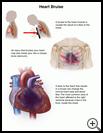
Bruised Heart
________________________________________________________________________
KEY POINTS
- A bruise to the heart muscle is usually the result of a blow to the chest. A blow to the chest and the heart that causes a bruise can change the normal heart beat and blood flow.
- Treatment depends on how serious your heart bruise is. You may need to stay in the hospital to be checked often. Your blood pressure and heart rhythm will be monitored frequently.
- Follow the full course of treatment prescribed by your healthcare provider. Ask your provider if there are activities you should avoid and when you should return to normal activities.
________________________________________________________________________
What is a heart bruise?
A bruise to the heart muscle is usually the result of a blow to the chest. It can be mild or serious and life-threatening.
It is also called a myocardial contusion or cardiac contusion.
The heart has 4 sections, or chambers. The upper chambers are called atria, and the lower chambers are called ventricles. The wall between the right and left atria is called the atrial septum. The wall between the right and left ventricles is called the ventricular septum.
Normally, blood flows from the right atrium into the right ventricle, and the right ventricle pumps it to the lungs to pick up oxygen. Blood returns from the lungs to the left atrium, which pumps into the left ventricle. The left ventricle pumps blood out of the heart to the body. A blow to the heart that results in a bruise can change the normal heart beat and blood flow. The most common area of the heart affected is the right ventricle because it lies in the front, inside the chest.
What is the cause?
A heart bruise is usually the result of a hard blow to the chest caused by:
- A motor vehicle accident
- A fall from a high place
- A sports injury
- A blast from an explosion
What are the signs and symptoms?
A heart bruise does not always cause symptoms. It depends on how hard you were hit and whether other parts of your body were hurt. For example, an injury that bruises your heart may also break your ribs or breast bone (sternum).
Signs and symptoms may include:
- Sore chest
- Bruises on the chest
- Pain when you take a deep breath
- Shortness of breath
- Low blood pressure
- Irregular heart rhythm
How is it diagnosed?
Your healthcare provider will ask about your symptoms and medical history and examine you. Your healthcare provider will ask about how you got injured. Tests may include:
- Blood tests
- Chest X-ray
- ECG (also called an EKG or electrocardiogram), which measures and records your heartbeat
- Echocardiogram, which uses sound waves (ultrasound) to see how well your heart is pumping
- MRI, which uses a strong magnetic field and radio waves to show detailed pictures of the heart
- CT scan, which uses X-rays and a computer to show detailed pictures of the heart
How is it treated?
Treatment depends on how serious your heart bruise is. A heart bruise may cause:
- Bleeding and swelling of the heart
- Damage to heart valves
- Problems with the electrical signals and the heart beat
- Problems with the heart pumping blood
You may need to stay in the hospital to be checked often. Your blood pressure and heart rhythm will be monitored. You may have an IV in your vein to give you fluids and medicines. If you are having trouble breathing, you may have a breathing tube and machine to assist with breathing.
How can I take care of myself?
Follow the full course of treatment prescribed by your healthcare provider.
Ask your provider:
- How and when you will get your test results
- How long it will take to recover
- If there are activities you should avoid and when you can return to your normal activities
- How to take care of yourself at home
- What symptoms or problems you should watch for and what to do if you have them
Make sure you know when you should come back for a checkup. Keep all appointments for provider visits or tests.
How can I help prevent a heart bruise?
- Always wear your seatbelt when in a motor vehicle.
- Use safety equipment when working from heights.
- Use protective equipment when playing impact sports.

